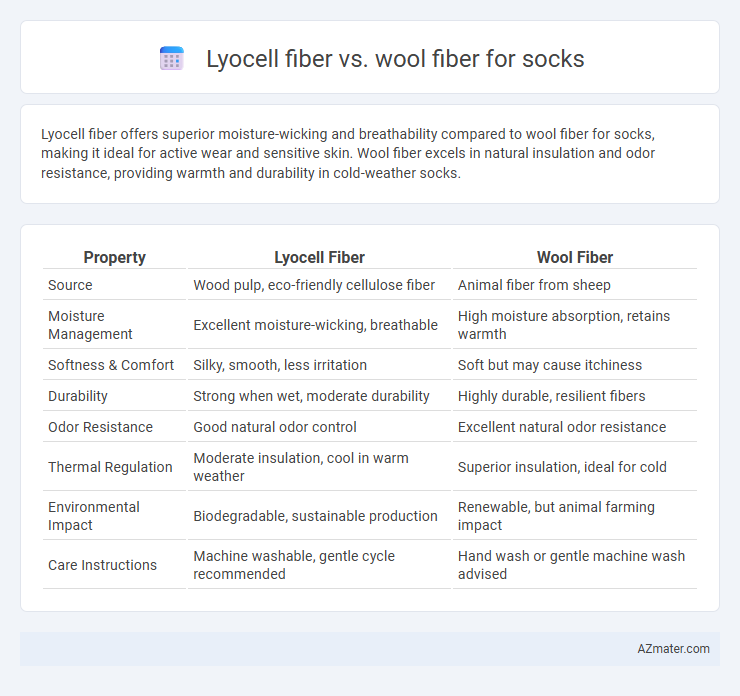Lyocell fiber offers superior moisture-wicking and breathability compared to wool fiber for socks, making it ideal for active wear and sensitive skin. Wool fiber excels in natural insulation and odor resistance, providing warmth and durability in cold-weather socks.
Table of Comparison
| Property | Lyocell Fiber | Wool Fiber |
|---|---|---|
| Source | Wood pulp, eco-friendly cellulose fiber | Animal fiber from sheep |
| Moisture Management | Excellent moisture-wicking, breathable | High moisture absorption, retains warmth |
| Softness & Comfort | Silky, smooth, less irritation | Soft but may cause itchiness |
| Durability | Strong when wet, moderate durability | Highly durable, resilient fibers |
| Odor Resistance | Good natural odor control | Excellent natural odor resistance |
| Thermal Regulation | Moderate insulation, cool in warm weather | Superior insulation, ideal for cold |
| Environmental Impact | Biodegradable, sustainable production | Renewable, but animal farming impact |
| Care Instructions | Machine washable, gentle cycle recommended | Hand wash or gentle machine wash advised |
Introduction to Lyocell and Wool Fibers
Lyocell fiber is a sustainable, biodegradable fabric made from wood pulp, known for its softness, moisture-wicking properties, and breathability, making it ideal for sock manufacturing. Wool fiber, sourced from sheep, offers excellent insulation, natural elasticity, and antimicrobial benefits that enhance comfort and durability in socks. Both fibers provide unique advantages, with Lyocell excelling in moisture management and environmental impact, while wool delivers superior warmth and resilience.
Origin and Production Process
Lyocell fiber is derived from sustainably sourced wood pulp, primarily eucalyptus trees, utilizing a closed-loop solvent spinning process that recycles 99% of the chemicals and water, making it eco-friendly and biodegradable. Wool fiber, sourced from the fleece of sheep, undergoes shearing followed by cleaning, carding, and spinning, relying on natural animal protein fibers that provide excellent insulation and moisture-wicking properties. The production of Lyocell emphasizes minimal environmental impact with a modern industrial process, whereas wool production focuses on traditional agricultural practices with renewable animal resources.
Environmental Sustainability Comparison
Lyocell fiber, derived from sustainably sourced wood pulp through a closed-loop process, offers superior environmental sustainability compared to wool fiber, which requires extensive land, water, and methane emissions from sheep farming. Lyocell production uses significantly less water and energy while avoiding animal welfare concerns, making it a more eco-friendly choice for sock manufacturing. Although wool is biodegradable and renewable, its larger carbon footprint and resource demands position Lyocell as the greener alternative for sustainable textile applications.
Comfort and Skin Sensitivity
Lyocell fiber offers superior moisture-wicking and breathability, making it ideal for sensitive skin by reducing irritation and fungal growth in socks. Wool fiber provides excellent insulation and natural antimicrobial properties but can sometimes cause itchiness or discomfort for sensitive skin types. For those prioritizing comfort and skin sensitivity, Lyocell socks are often preferred due to their smooth texture and hypoallergenic qualities.
Moisture Management and Breathability
Lyocell fibers exhibit superior moisture management compared to wool fibers by absorbing and wicking moisture away from the skin more efficiently, keeping feet dry during extended wear. Wool fibers provide excellent breathability and natural temperature regulation but tend to retain more moisture, which can result in slower drying times. For socks, Lyocell's enhanced moisture-wicking and quick-drying properties make it ideal for active use, while wool remains favorable for insulation and odor resistance in cooler climates.
Durability and Longevity in Socks
Lyocell fiber offers high durability in socks due to its strong cellulose structure, resulting in less wear and tear compared to natural fibers. Wool fiber provides excellent longevity with inherent elasticity and resilience, maintaining shape and cushioning through repeated use. Socks made from blends of Lyocell and wool combine moisture management and abrasion resistance, enhancing overall durability and lifespan.
Thermal Regulation Properties
Lyocell fiber offers excellent moisture absorption and breathability, enabling efficient thermal regulation by wicking sweat away and keeping feet dry, which helps maintain a comfortable temperature in warm conditions. Wool fiber excels in insulating properties, trapping air and providing superior warmth even when damp, making it ideal for cold environments. Combining Lyocell's moisture management with wool's thermal insulation can create socks that effectively regulate temperature across diverse climates.
Odor Resistance and Hygiene
Lyocell fiber offers superior odor resistance and moisture-wicking properties compared to wool, making it ideal for maintaining hygiene in socks during extended wear. Wool fibers naturally resist odor through lanolin content but can retain moisture longer, which might reduce overall freshness. Combining Lyocell's quick-dry ability with wool's antimicrobial traits provides a balanced solution for odor control and hygiene in performance socks.
Cost Considerations and Accessibility
Lyocell fiber generally offers a more cost-effective option for socks due to its efficient production process and use of sustainable wood pulp, making it widely accessible for mass-market consumers. Wool fiber, although premium in warmth and durability, tends to carry higher costs attributed to animal husbandry and seasonal availability, limiting accessibility in some regions. Bulk purchasing and blended fabric options can influence overall pricing and availability for both fibers in the sock industry.
Best Use Cases: Lyocell vs Wool Socks
Lyocell socks excel in moisture-wicking and breathability, making them ideal for athletic activities and hot climates where sweat management is crucial. Wool socks offer superior insulation and odor resistance, perfect for cold weather conditions and outdoor adventures requiring warmth and durability. Choosing between Lyocell and wool socks depends on the specific environmental demands and user comfort preferences for either temperature regulation or thermal protection.

Infographic: Lyocell fiber vs Wool fiber for Sock
 azmater.com
azmater.com